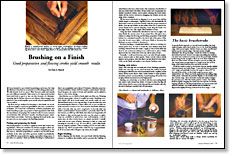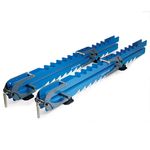Brushing On a Finish
Good preparation and flowing strokes yield smooth results
Synopsis: Because paint and varnish are different materials, they call for different brush techniques, writes Chris A. Minick. He talks about how to select and prepare a finish, covering fast-drying finishes, oil-based varnishes, oil-based polyurethanes, shellac, water-based finishes and retarders to slow drying time. He explains how to thin a finish with solvent to make it brush-ready, how to apply with the brush, and what to do with defects. Photos illustrate proper brushstroke technique. Side information explains how to choose the right brush for the job and how to keep it clean.
If you learned to use a brush by painting your house, the clear finish you brushed on your latest woodworking project probably doesn’t look too good. Why? Because paint and varnish are very different materials. Paint needs to be vigorously brushed back and forth to get it to lay out thin because it’s thixotropic, meaning that it’s thicker when at rest, thinner when energy is applied to it. But varnish applies most evenly when it’s gently flowed onto a surface.
My flow-and-go method for brushing a clear finish on woodwork was taught to me by my grandfather who was a professional finisher. I’ve found his combination of finish preparation and brush handling to give my projects a final appearance that rivals the smoothness of spraying. The method works for most common wood finishes like oil-based varnish, brushing lacquer, waterbased finish and shellac. But before dipping the brush in the can, we must choose and prepare the finishing material.
Picking and preparing the finish
Fast-drying finishes are harder to apply by brush than slower drying finishes. Oil-based varnishes dry slowly enough to allow ample time for leveling, allowing you to work at a leisurely pace. For that reason, oil-based polyurethane varnish is my favorite brushon finish. At the other end of the spectrum, shellac is probably the most difficult common finish to apply, especially to large areas—it just dries too quickly. I limit my shellac brushing to small projects that I can completely coat in about 10 minutes. Likewise, most water-based finishes brush well but require a quick hand. Solventbased lacquers are easier to brush, and retarders can be added to them to slow down drying.
Most finishes are too thick to brush right out of the can. Thinning with the appropriate solvent is usually necessary. Brushing a toothick finish will show brush marks and streaks while an overthinned finish tends to run, sag and drip. To get the ideal mix, start by transferring the finish to a clean coffee can, so you can thin only the amount you want to use. Now measure the finish’s thickness with a viscosity drip cup and a stopwatch. A viscosity drip cup holds a predetermined amount and has a precisely sized hole in the bottom; you fill it up with finish, then time how long it takes all the finish to drip out through the hole (see the photo at right). Cups are available in paint stores and, unfortunately, come in many sizes (in other words, there’s no simple standard). I usually work with about a pint of finish, thinning it a little at a time and checking its viscosity as I go. If I over thin it, I add a little finish from its original container.
From Fine Woodworking #98
For the full article, download the PDF below:
Fine Woodworking Recommended Products

Rockler Deluxe Panel Clamp

Estwing Dead-Blow Mallet

Stanley Powerlock 16-ft. tape measure





















Log in or create an account to post a comment.
Sign up Log in